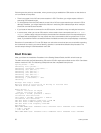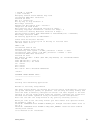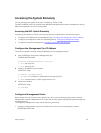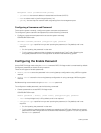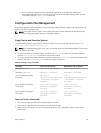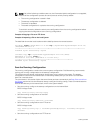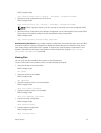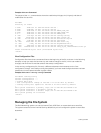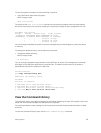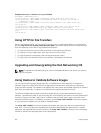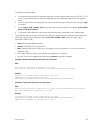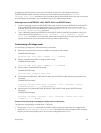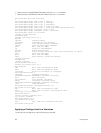
Example of the dir Command
The output of the dir command also shows the read/write privileges, size (in bytes), and date of
modification for each file.
Dell#dir
Directory of flash:
1 drwx 4096 Jan 01 1980 00:00:00 +00:00 .
2 drwx 2048 May 10 2011 14:45:15 +00:00 ..
3 drwx 4096 Feb 17 2011 00:28:00 +00:00 TRACE_LOG_DIR
4 drwx 4096 Feb 17 2011 00:28:02 +00:00 CORE_DUMP_DIR
5 d--- 4096 Feb 17 2011 00:28:02 +00:00 ADMIN_DIR
6 -rwx 1272 Apr 29 2011 16:15:14 +00:00 startup-config
7 -rwx 10093 Feb 17 2011 20:48:02 +00:00 abhi-jan26.cfg
8 -rwx 217155 Feb 22 2011 23:14:34 +00:00 show-tech-cfg.txt
9 -rwx 5162 Mar 02 2011 04:02:58 +00:00 runn-feb6
10 -rwx 10507 Mar 03 2011 01:17:16 +00:00 abhi-feb7.cfg
11 -rwx 4 May 06 2011 22:05:06 +00:00 dhcpBindConflict
12 -rwx 6900 Feb 17 2011 04:43:12 +00:00 startup-config.bak
13 -rwx 1244038 Feb 13 2011 04:27:16 +00:00 f10cp_sysd_110213042625.acore.gz
flash: 2143281152 bytes total (2123755520 bytes free)
--More--
View Configuration Files
Configuration files have three commented lines at the beginning of the file, as shown in the following
example, to help you track the last time any user made a change to the file, which user made the
changes, and when the file was last saved to the startup-configuration.
In the running-configuration file, if there is a difference between the timestamp on the “Last
configuration change,” and “Startup-config last updated,” you have made changes that have not been
saved and will not be preserved after a system reboot.
Example of the show running-config Command
Dell#show running-config
Current Configuration ...
Current Configuration ...
! Version E8-3-16-0
! Last configuration change at Tue Mar 6 11:51:50 2012 by default
! Startup-config last updated at Tue Mar 6 07:41:23 2012 by default
!
boot system stack-unit 5 primary tftp://10.11.200.241/dt-m1000e-3-a2
boot system stack-unit 5 secondary system: B:
boot system stack-unit 5 default tftp://10.11.200.241/dt-m1000e-3-b2
boot system gateway 10.11.209.254
--More--
Managing the File System
The Dell Networking system can use the internal Flash, USB Flash, or remote devices to store files.
The system stores files on the internal Flash by default but you can configure the system to store files
elsewhere.
58
Getting Started



